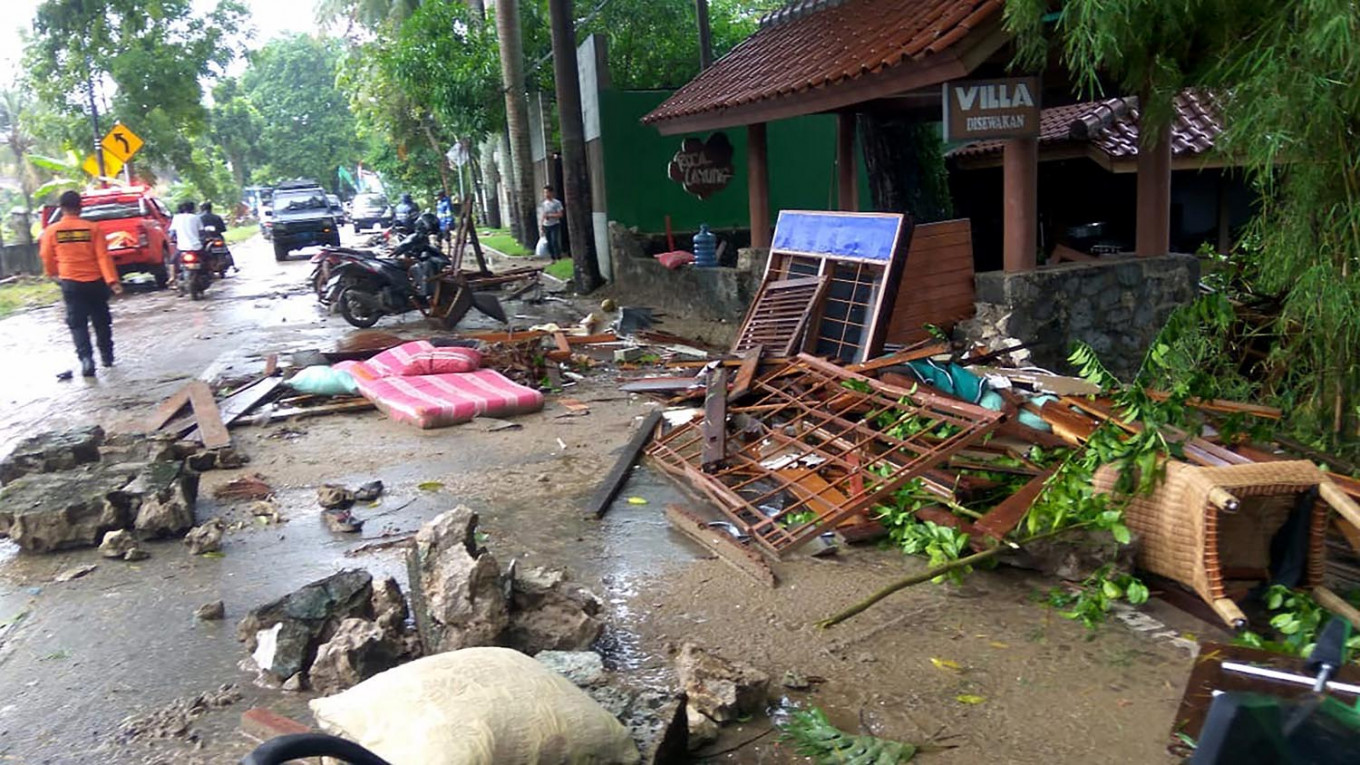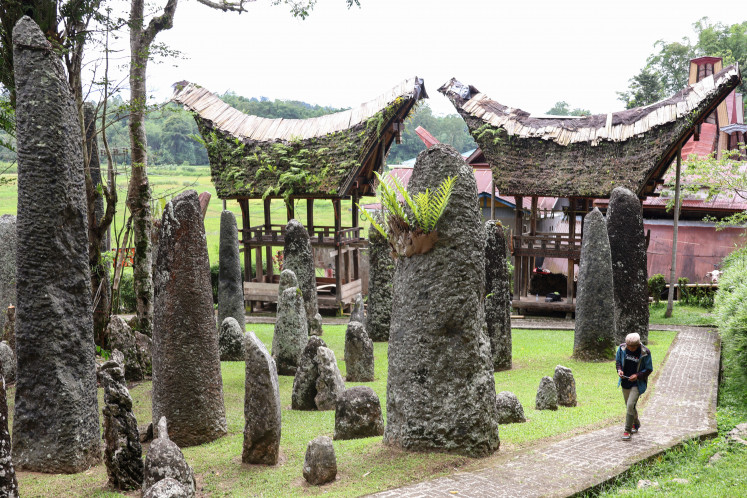Popular Reads
Top Results
Can't find what you're looking for?
View all search resultsPopular Reads
Top Results
Can't find what you're looking for?
View all search resultsCommentary: Curb threat of malaria following Sunda Strait tsunami
The Sunda Strait tsunami of Dec. 22 has not only shown Indonesia’s high risk for natural disasters, but has also set off an alarm on the possible spread of disease in unhealthy environments.
Change text size
Gift Premium Articles
to Anyone
 Debris from damaged buildings is seen on a street on Carita beach on December 23, 2018, after the area was hit by a tsunami on December 22 that was triggered by an eruption of the Anak Krakatoa volcano. - A tsunami triggered by a volcanic eruption killed 43 people and injured hundreds more as it slammed without warning into tourist beaches and coastal areas around Indonesia's Sunda Strait on the night of December 22, sending panicked holiday makers and residents fleeing. (AFP/Ronald)
Debris from damaged buildings is seen on a street on Carita beach on December 23, 2018, after the area was hit by a tsunami on December 22 that was triggered by an eruption of the Anak Krakatoa volcano. - A tsunami triggered by a volcanic eruption killed 43 people and injured hundreds more as it slammed without warning into tourist beaches and coastal areas around Indonesia's Sunda Strait on the night of December 22, sending panicked holiday makers and residents fleeing. (AFP/Ronald)
T
he Sunda Strait tsunami of Dec. 22 has not only shown Indonesia’s high risk for natural disasters, but has also set off an alarm on the possible spread of disease in unhealthy environments. With many areas still exposed to dirty water, garbage and debris, the people affected by the tsunami are more likely at risk of contracting illnesses from the damaged and polluted environment, such as malaria.
Days after the tsunami hit several areas in Banten and Lampung, including popular resort beaches, Health Minister Nila Djuwita Anfasa Moeloek reminded people in the affected areas to take precautionary measures against illnesses caused by unhealthy environments.
The tsunami, triggered by the volcanic activity of Anak Krakatau in the Sunda Strait, led to the death of at least 430 people, injured 1,500 others and over 150 remain missing.
While malaria in Banten has been reported as declining, certain areas in Pandeglang, the worst hit regency, are still at risk of the waterborne illness. According to the Banten Health Agency, six districts in Pandeglang were not malaria-free even before the disaster, while malaria cases have occurred in seven districts of Lebak regency. Lagoons along the southern coast have been blamed as the major source of the rampant malaria in both regencies, as they are the breeding grounds for the larvae of Anopheles mosquitoes, the carrier of the Plasmodium parasite that causes malaria. The Banten administration says it is focusing on malaria management programs in achieving its malaria-free goal by 2020.
Banten and Lampung should learn from West Lombok authorities in West Nusa Tenggara. They declared an extraordinary occurrence (KLB) of malaria after a 6.4-magnitude earthquake hit the regency in July 2018, which helped the disease spread rapidly due to the damaged and polluted environment. Authorities might hate declaring such emergencies that could increasingly scare away tourists, but their priority should be to save lives.
Papua, West Papua and East Nusa Tenggara are three other provinces where malaria is prominent, apart from several areas in Kalimantan. Of Indonesia’s 514 regencies and municipalities, only 272 are malaria-free, while over 191 million people (73 percent of the population) live in malaria-free areas, according to the Health Ministry.
There were 209,413 confirmed malaria cases in 2015, barely half of the 465,764 confirmed cases in 2010. Urgent efforts are however still necessary to prevent the life-threatening disease from reemerging. According to the ministry, 10.7 million Indonesians still live in areas with middle and high rates of malaria transmission.
The “World Malaria Report 2018” that the World Health Organization (WHO) issued last November says several countries have failed to meet their targets in reducing the global rate of malaria-related infections and deaths. The report says new malaria cases fell steadily until 2016, but then increased in 2017 to 219 million from 217 million the previous year.
Among the countries surveyed, those showing some progress in combating malaria include India, representing 4 percent of the global malaria burden, whose number of cases has now dropped by almost a quarter. Forty-six countries are nearing elimination, up from 37 previously. India and 10 African countries account for 70 percent of all malaria-related deaths in 2017.
Countries must also be on the alert to antimalarial multidrug resistance, which was first identified a decade ago on the Thai-Cambodia border.
Alarmingly, Indonesia is among the 20 countries where total malaria cases in each of the countries exceeded 300,000 in 2017. The report says Indonesia saw an increase of more than 100,000 malaria cases between 2016 and 2017. This may hamper the country’s efforts to eliminate malaria by 2030, a historic global pledge agreed at the 2013 East Asia Summit with the creation of the Asia Pacific Leaders Malaria Alliance (APLMA) to accelerate antimalaria efforts.
During the Singapore summit last November, Indonesian and other regional leaders reaffirmed their commitment to achieve a malaria-free Asia Pacific by 2030 and welcomed efforts to implement proposed actions in the APLMA Malaria Elimination Roadmap.
APLMA chief executive officer Ben Rolfe said malaria was still a major global public health challenge in which insecticide resistance of mosquitoes and antimalarial drug resistance were among the main constraints to combating the disease. Hence, advanced medical and healthcare services were key to successfully decreasing malaria cases and deaths.
Tafenoquine, a new drug introduced as an alternative to primaquine that has been reportedly declining in antimalarial effectiveness, was hoped to fundamentally change the way countries treat latent malarial infections, Rolfe said. Long-lasting mosquito nets and indoor residual sprays with improved formulas should also ensure effective strategies toward malaria eradication.
“We’ve previously seen in some areas that with effective intervention, malaria incidences plummeted almost immediately,” Rolfe told The Jakarta Post. The fight against malaria needs close coordination with neighboring countries as well. Otherwise, the disease can spread across borders; as Rolfe said, “Mosquitoes do not have passports.”
Effective interventions, including ensuring wider access to malaria treatment and vector control tools like indoor residual sprays and long-lasting bed nets, as well as improved screening and diagnoses, are essential to stopping the spread of malaria. Otherwise, Indonesia may miss its 2030 malaria-free target and expose millions more to the potentially fatal disease.









